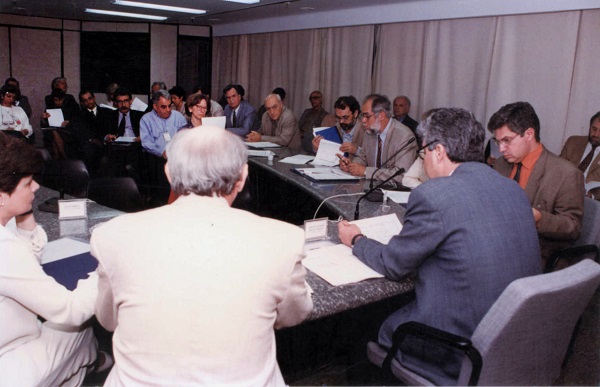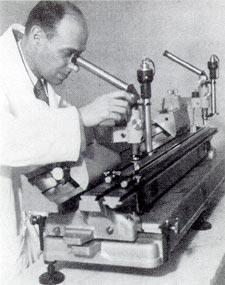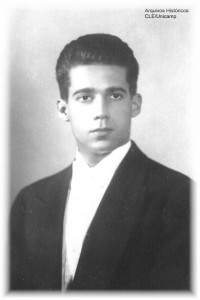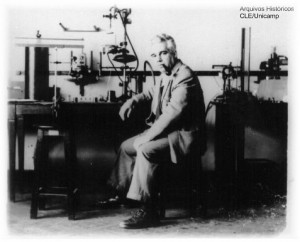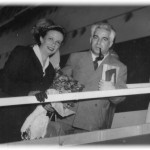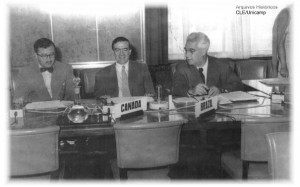
When we started the construction of LNLS, in 1986, and much before that, in its “pre-history”, there already was the intention of involving the Brazilian national industry in the construction of the equipment. Looking back from 2015, it is difficult to imagine what the Brazilian industry was in 1985. It is even more difficult to conceive that, in some sectors, among them the metal-mechanical sector, it was more sophisticated than it is today. The opening of the Brazilian economy, required, but conducted in a confused and trapping manner by Collor Government, terminated with a good part of the most sophisticated industry that was in Brazil at that time. Out of all the materials required to construct the accelerators, two got highlight for their weight (literally): steel and copper. To the magnets and vacuum chambers, we needed steel, and to the coils of the electromagnets we needed OFHC copper with low content of oxygen.
I remember the visit made to our hangar, by an specialist in ultra-high vacuum of Balzers that states to us, in an arrogant manner, that “it is impossible to manufacture ultra-high vacuum chambers” with Brazilian steel. “You will have to import”. It is not required to say that it was a wonderful incentive so that we would look for a Brazilian supplier to our needs. Ricardo and I shared a healthy disregard to such type of specialist. I think we both thought, without speaking up, each time we´ve heard statements of such type, more or less the same thing: “Ah, yes! No way? You will see!” To the manufacturing of the magnets and vacuum chambers, there were two questions not answered. There would be in Brazil steel with the required characteristics? And the laser-cutting method that we intended to use would not affect in a negative manner the magnetic properties of the material on its edges? No one has used such technique to manufacture precision electromagnets until LNLS considered it as an option, given the very special conditions we were facing. When we started, no one had the answers to such questions. The experience showed that there was the required steel in Brazil, for the magnets (SAE1006, acquired in the national market and re-laminated by Mangels), as well as for the chambers (AISI 316L), and that the laser cutting was a feasible and very flexible technique to the production of batches relatively small of electromagnets*. This, naturally, did not occur from night to day. In another occasion, we could told the long history of the development of the processes for steel, for example, the vacuum chambers cleaning and welding, and, for the magnets, the improvement of the magnetic properties.
Another history, funnier, is the one of copper for the coils of the electromagnets. CERN has recommended the Finnish company Outokumpu to us, which was their supplier. It is clear that, with such recommendation, we were calm regarding the quality of the Finnish product. But, I was not satisfied with having to import copper. A research revealed the existence of Termomecânica in São Paulo, property of Salvador Arena. Referencing to my “specialists”, all of them were unanimous in two points: it was a best-quality company and a company owned by an exceptional businessman, one of the most dedicated to the technological development of his products, only a little moody. I thought he fitted in the profile of a potential supplier to LNLS, and there I went to explain the LNLS project and its needs to him. I was welcomed, I have heard for hours an explanation on the beautiful educational program that was the project of his heart, I could expose our project in a brief manner, but Arena was precise about it – “I do not enter in such business. I do not want anything with the government. I will not go right. Forget it, you will not reach it. Termomecânica will not supply to you.” (I put the text between quotes, safeguarding that they could not have been Arena’s exact words, but the sense is the same.)
I confess I got disappointed, but the talk was not in vain. It served to me to understand how he thought, and to outline a strategy to convince him. We imported, with the help of CERN, a ton of OFHC copper from Outokumpu (a fraction of what we needed) in the specifications required to the coils of the dipole of the ring. The copper supplied by Outokumpu was OFHC/OFE – 99.99% minimum Cu with up to 0.0010% max of oxygen. As soon as the material arrived, I called to Salvador Arena to tell him: “You did not want to supply, I imported from Outokumpu, your competitor”. What was heard on the other side of the line cannot be reproduced in the profusion of the insulting words where Arena was prodigal. Underneath, I was referred to as frivolous and unreliable, and he assured me in the most emphatic terms that he has never said that Termodinâmica would not provide us with the copper of low content of oxygen we needed. And he virtually ordered me to go back there immediately with the specifications that they would develop the material to us. And it was what they did. Thanks to Outokumpu’s import strategy, the copper supplied by Termomecânica is until today complying with its role with distinction, not only in the dipoles, but in all electromagnets of LNLS (OHFC/OF certificate – 99.95% minimum Cu + Ag with up to 0.0010% max of oxygen, but with OFE quality). Also here, there is a long story of development made by the LNLS team, from the materials up to the finished product. But, let’s leave it to another opportunity.
Prof. Cylon Gonçalves da Silva
* I thank Guilherme Franco, Osmar Bagnato, and Ricardo Rodrigues, of LNLS team, for having refreshed my memory on the types of steel deployed, as well as the technical details of OFHC copper.

